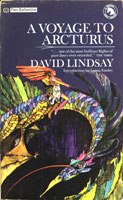
David Lindsay (1876–1945) is a fantasy writer best known for his first book, A Voyage to Arcturus. Published in 1920, it has since been called “the greatest imaginative work of the twentieth century” (Colin Wilson), “a stupendous ontological fable” (E H Visiak), “a masterpiece... an extraordinary work” (Clive Barker), “that shattering, intolerable, and irresistible work” (C S Lewis), and “a singular, frustrating, baffling and ultimately rewarding book” (Nina Allan). John Grant, in The Encyclopedia of Fantasy, calls it “a masterpiece of allegorical fantasy”, while Brian Aldiss (Trillion Year Spree) says: “Read as allegory, these adventures defy interpretation; they have to be accepted as vision.”
Lindsay was one of the great mavericks of fantasy literature, arriving fully-formed and unique — a “phoenix”, as they used to have it — from his first book. And that book is certainly not to everyone’s taste. Famously, on its initial release, it sold less than 600 copies. As Michael Moorcock and James Cawthorn put it, in Fantasy: The 100 Best Books:
Arcturus itself is not an ingratiating work; the shelf it occupies is a short one, reserved for titles more often to be found in lists than in reader’s pockets. The message it spells out is no comforting one.
But Lindsay himself said that as long as publishing exists he will have readers, however few, and he has been proved right. Arcturus, and his subsequent novels The Haunted Woman (1922), Sphinx (1923), The Adventures of Monsieur de Mailly (1926) and Devil’s Tor (1932) sold poorly but have since found a growing audience of devotees, enabling his unpublished works (The Violet Apple (written 1924, published 1976), and the unfinished The Witch (begun 1932, published 1976)) to be brought out.
Influenced by George MacDonald, Nietzsche, Schopenhauer and Carlyle (see Influences), Lindsay’s overriding theme throughout his works is the need to see past the superficialities, illusions and traps of this world, to find, beyond them, the really authentic and fulfilling in human existence — to arrive at something he calls, in Arcturus, Muspel: the true spiritual home of all living souls.
A Voyage to Arcturus is an intensely inventive work of the imagination, set in a wild and wholly original fantasy world. His subsequent books are mostly set in the mundane, everyday reality of 1920s/1930s England — but a reality in which numinous doors are opened onto more intense and profound levels of awareness; these latter books deal with how difficult it is to hold onto such elevated states of being when you are surrounded by the petty social tangles of a mundane existence.

I can’t begin to convey to you the power of Lindsay’s vision; I found it overwhelming when I first read the book, thirty years ago, and I’ve seldom seen its equal outside Blake.
— Philip Pullman, Talk to the UK Sea of Faith National Conference, 2002
David Lindsay’s A Voyage To Arcturus is a visionary novel that means a lot to me, it reads like it was spoken out of the air, like a prophetic work.
— David Keenan, Standing On The Edge Of Getting It On: My Favourite Science Fiction, at Forbidden Planet.com.
One cannot simply say that here disbelief is suspended; a more difficult thing had been done; the reader is given new vistas of his mortal fears and immortal longings. Good and evil intermix, at times seem the same. The invention is continuous, the sense of mystery sustained.
— The Times, “Precursors to Science Fiction Get a Second Reading”, 29th August 1963
I am an indurated publisher. I have read hundreds of novels, but it affected me as profoundly as when I was an impressionable youth and read Poe for the first time!
— Victor Gollancz, quoted in The Strange Genius of David Lindsay, p. 95-96
